Accepted Scientific Name: Denmoza rhodacantha (Salm-Dyck) Britton & Rose
Cactaceae (Britton & Rose) 3: 79. 1922 [12 Oct 1922] Britton & Rose
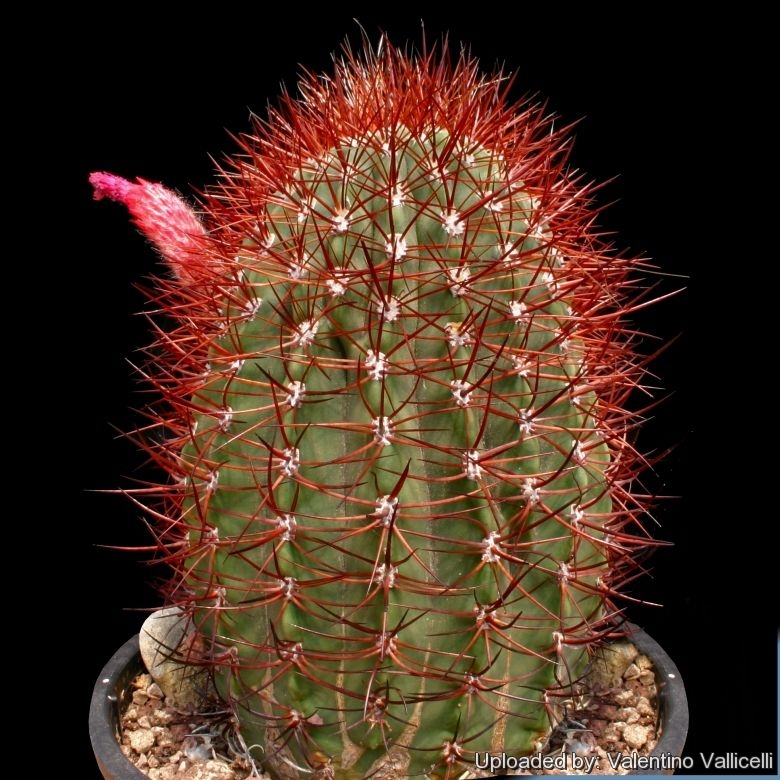
Cereus rhodacanthus (Denmoza rhodacantha) Photo by: Valentino Vallicelli
It's specific name comes from old Greek and means ''red spine'' for the colour of its clusters of spines. However the spines shape and colour of this species is variable. D. rhodacantha also changes considerably in the habit with age and the old specimen after many years start producing long white bristle. This white bristled form was previously known with the name of Denmoza erythrocephala. Denmoza ''rhodacantha'' and ''erythrocephala'' looks very different but are the same species.
It's a barrel type of cactus and stay globular during a long period before becoming shortly column-shaped.
Origin and Habitat: Denmoza rhodacanthaSN|7993]]SN|7993]] is widespread throughout the mountains of Argentina, where it occurs in Mendoza, San Juan, La Rioja, Tucumán, Catamarca and Salta.
Altitude range: This species at elevations between 800 and 2800 metres of elevation above sea level.
Habitat: Eastern slopes and foothills on monte habitat, in gravel soils, together with Cereus aethiopsSN|7679]]SN|6944]], Echinopsis leucanthaSN|8246]]SN|8246]], Opuntia sulphureaSN|32053]]SN|32053]], Maihueniopsis glomerataSN|7342]]SN|7342]], Eriosyce strausianaSN|18]]SN|18]] and TrichoSN'> 7680' alt='6944'>Cereus candicans#SN#7679'>Tricho[[Cereus candicansSN' style='border:none;'>. Denmoza rhodacanthaSN|7993]]SN|7993]] has a wide range, is locally abundant, is present in several protected areas, and is not utilised. The major threats to this species are mining activities and fires.
7680' alt='6944'>Cereus candicans#SN#7679'>Tricho[[Cereus candicansSN' style='border:none;'>. Denmoza rhodacanthaSN|7993]]SN|7993]] has a wide range, is locally abundant, is present in several protected areas, and is not utilised. The major threats to this species are mining activities and fires.
Synonyms:
See all synonyms of Denmoza rhodacantha
back
Accepted name in llifle Database:Denmoza rhodacantha (Salm-Dyck) Britton & RoseCactaceae (Britton & Rose) 3: 79. 1922 [12 Oct 1922]Synonymy: 11
Cultivars
(2):
back
Description: Denmoza rhodacanthaSN|7993]]SN|7993]] is a large slowly growing columnar cactus. It stay globulous during a long period before becoming shortly column-shaped, 0.5 to 1.5(-2) cm high.
Stem: The plant's diameter ranges from 15 to 30 cm, the stem colour varies from pale green to dark green
Ribs: 15 to 30, parallel straight, slightly undulate, broad basally up to 1 cm tall.
Areoles: Well spaced at first, later confluent. Flower producing areoles often bears many long bristles and up to 7 cm long spines.
Radial spines: 8 to 10, brownish-red becoming grey, awl shaped and slightly curved, very different in young and old plants. There is also a form ("flavispina") with orange-yellow spines.
Central spines: 1 (But often absent) stouter up to 3 cm long.
Flowers: They need to reach a reasonable size in cultivation before producing their flowers. First flowers appear near the top of the stem, however, on plants of very unequal age and size, some time on relatively young plants but also on 30-40 years old specimens! Flowers are zygomorphous (bilaterally symmetrical), of a maximum length of 7.5 cm, reddish to bright scarlet in colour and have white hair on the tube. Floral tube usually curved and slightly dilated above the pericarpel, which bears small appressed scales. The flower open sufficiently widely so that the stigma and red stamen filaments are visible from outside. Anther exerted at least 10 mm beyond the tube.
Fruits: Globose, dry at maturity, dehiscent with tuft of short hair-like spines.
Notes: The genus Denmoza comprises only one species allied to Cleistocactus, but it has also been referred to Echinopsis, Cereus, Echinocactus and Pilocereus.
The plants described as PiloSN'> 8001' alt='8003'>Cereus erythrocephalus#SN#8003'>Pilo[[Cereus erythrocephalusSN' style='border:none;'> and later transferred to Denmoza has sometimes, for instance by Backeberg, been considered as another species of the genus. D. rhodacantha changes considerably in the habit with age. The description of Denmoza rhodacantha refers to young plants having strong spines in areoles. Old plants of the same species with multiple number of spines and sometimes with thin, 6 cm long bristly spines correspond to the description of Denmoza erythrosepala.
8001' alt='8003'>Cereus erythrocephalus#SN#8003'>Pilo[[Cereus erythrocephalusSN' style='border:none;'> and later transferred to Denmoza has sometimes, for instance by Backeberg, been considered as another species of the genus. D. rhodacantha changes considerably in the habit with age. The description of Denmoza rhodacantha refers to young plants having strong spines in areoles. Old plants of the same species with multiple number of spines and sometimes with thin, 6 cm long bristly spines correspond to the description of Denmoza erythrosepala.
Bibliography: Major references and further lectures
1) N. L. Britton, J. N. Rose: “The Cactaceae. Descriptions and Illustrations of Plants of the Cactus Family.” Vol I, The Carnegie Institution of Washington, Washington 1919
2) Edward Anderson “The Cactus family” Timber Press, Incorporated, 2001
3) James Cullen, Sabina G. Knees, H. Suzanne Cubey "The European Garden Flora Flowering Plants: A Manual for the Identification of Plants Cultivated in Europe, Both Out-of-Doors and Under Glass" Cambridge University Press, 11/Aug/2011
4) David R Hunt; Nigel P Taylor; Graham Charles; International Cactaceae Systematics Group. "The New Cactus Lexicon" dh books, 2006
5) Méndez, E. & Ortega-Baes, P. 2013. Denmoza rhodacantha. The IUCN Red List of Threatened Species. Version 2014.3. <www.iucnredlist.org>. Downloaded on 12 April 2015.
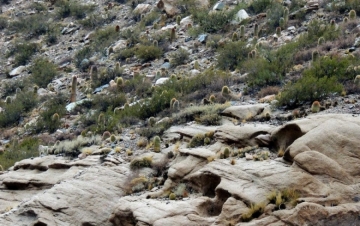 A large colony in habitat (Mendoza province, Argentina) (Denmoza rhodacantha) Photo by: Carolina González
A large colony in habitat (Mendoza province, Argentina) (Denmoza rhodacantha) Photo by: Carolina González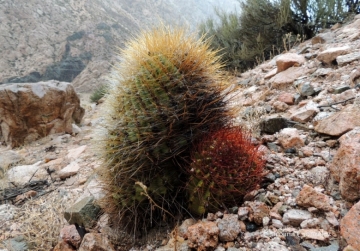 Yellow and red spines forms in habitat (Mendoza province, Argentina) (Denmoza rhodacantha) Photo by: Carolina González
Yellow and red spines forms in habitat (Mendoza province, Argentina) (Denmoza rhodacantha) Photo by: Carolina González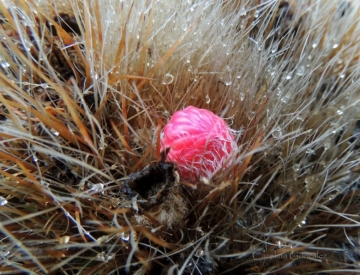 Buds. First flowers appear some time on relatively young plants but also on 30-40 years old specimens! (Denmoza rhodacantha) Photo by: Carolina González
Buds. First flowers appear some time on relatively young plants but also on 30-40 years old specimens! (Denmoza rhodacantha) Photo by: Carolina González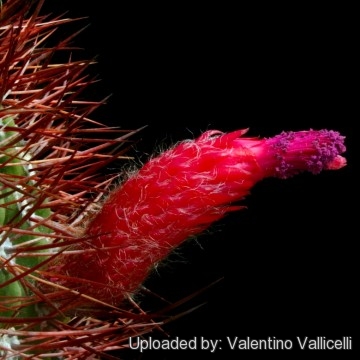 It has extraordinary scarlet zygomorphic, tubular flowers. (Denmoza rhodacantha) Photo by: Valentino Vallicelli
It has extraordinary scarlet zygomorphic, tubular flowers. (Denmoza rhodacantha) Photo by: Valentino Vallicelli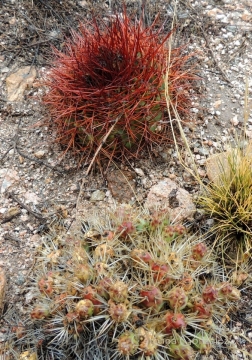 Red spines form (Mendoza province, Argentina) (Denmoza rhodacantha) Photo by: Carolina González
Red spines form (Mendoza province, Argentina) (Denmoza rhodacantha) Photo by: Carolina González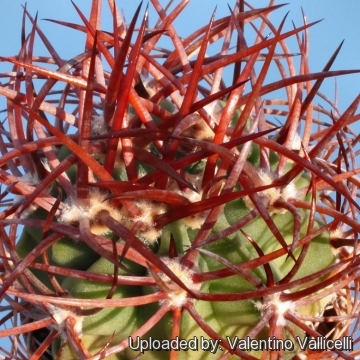 Cereus rhodacanthus (Denmoza rhodacantha) Photo by: Valentino Vallicelli
Cereus rhodacanthus (Denmoza rhodacantha) Photo by: Valentino Vallicelli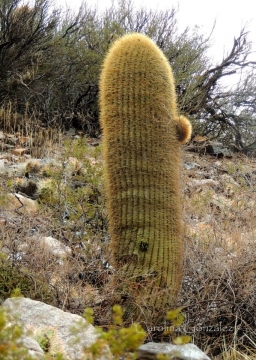 A tall columnar specimen (Mendoza province, Argentina) (Denmoza rhodacantha) Photo by: Carolina González
A tall columnar specimen (Mendoza province, Argentina) (Denmoza rhodacantha) Photo by: Carolina González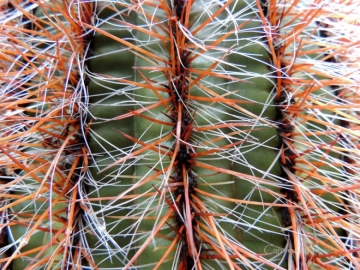 Spines (Mendoza province, Argentina) (Denmoza rhodacantha) Photo by: Carolina González
Spines (Mendoza province, Argentina) (Denmoza rhodacantha) Photo by: Carolina GonzálezCultivation and Propagation: Denmoza rhodacanthaSN|7993]]SN|7993]] is a very slow growing cactus but requires no special condition in cultivation, need full sun. It is old hardy as low as -8°C (or less). It needs a fertile, well drained soil mix. Water the plants well and allow them to dry before watering again. During the growing season fertilize them monthly with a balanced fertilizer
Sun Exposure: Outside full sun, but during hot summers the cactus are subject to sun burning, so grow them in light shade. Inside they need bright light, and some direct sun. During winter months, put them in a cool luminous place and encourage them to enter winter dormancy by withholding water and fertiliser over the winter, as they will etiolate, or become thin, due to lower levels of light. They are susceptible to fungal diseases if over-watered, but are not nearly as sensitive as many other cacti, especially in warm weather. They tend characteristically towards black rotted spots unless watering is moderate and only in hot weather. If kept damp through cold periods, they will invariably suffer.
Propagation: Seeds.
Your Photos
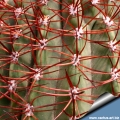
by Cactus Art
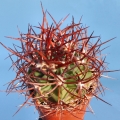
by Valentino Vallicelli

by Valentino Vallicelli

by Carolina González
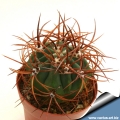
by Cactus Art























